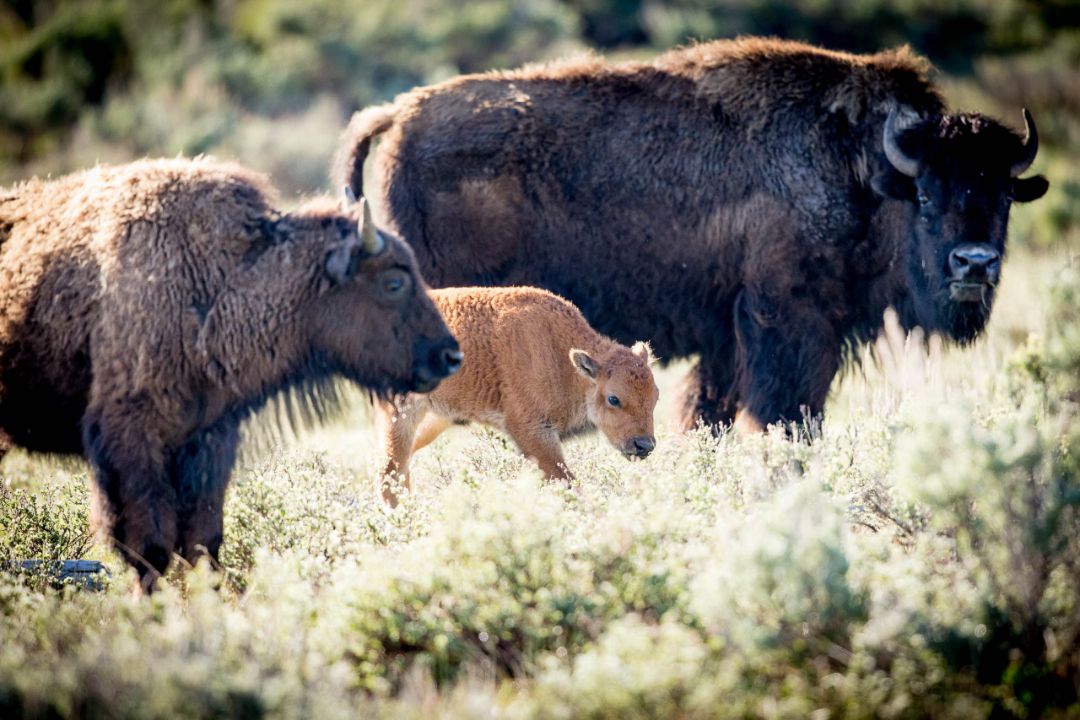Wildlife Photography Tips

Above photo: Bison wander in Yellowstone National Park.
Story by Jaymi Heimbuch and Eleni Georgeou. Photos by Jaymi Heimbuch
Jaymi is a wildlife photographer based in San Francisco, California. See more of her work on her website. Eleni is a senior copywriter at 360i in New York City.
If you’re new to wildlife photography, don’t fret.
Photographer Jaymi Heimbuch believes that there’s a story in each moment, in each individual animal; figuring out how to tell that story is part of the wonderful challenge of wildlife photography. Here are her tips for amateur photographers:
• Stay patient: The biggest mistake photographers make is being impatient. When they rush to get closer or capture action images, it can sometimes make animals nervous, pushing them out of their comfort zone. This causes them to go on alert, stop feeding or resting, or leave the area. But when we sit still for a long period, it allows the animal's natural behavior to unfold, leading to far more interesting and unique imagery.
• Don’t bait: Baiting is the common act of putting out a food source to attract an animal for a photograph, like using mice from the pet store to attract owls. Unfortunately, this has negative consequences, including habituating wildlife to people (which can lead to an animal’s untimely death), spreading disease, altering natural behavior, and altering the migration patterns of an animal. The safest bet is to avoid using bait or lures of any kind. Instead, learn everything you can about animals’ natural behaviors so you can be in the right place at the right time.
• Use blinds: A blind is a camouflaged structure you can stand inside while shooting, so the animal doesn’t realize you’re there. Most commonly used for photographing birds since they’re so easily frightened, blinds are helpful because they allow you to have minimal impact on an animal’s behavior. Sometimes a car also works well because animals tend to be less skittish seeing a stationary vehicle than a person walking around.
• Pay attention to body language: Being alert to an animal’s body language can keep you safe and help avoid a dangerous situation. It’s fun to get action shots of big animals like elk or bears, but the action could be stemming from an animal’s stress, frustration or defensiveness. It’s important to remember that you’re sharing space with a wild animal. If it looks as though the animal is projecting unwelcome attention toward you, the best defense is to give them space.
• Use a basic lens: Many photographers get wrapped up in the gear and forget that incredible photos can be made with the most basic equipment; it’s really about the creativity and vision of the person holding the camera. While shooting in Alaska, Jaymi only had an inexpensive 50mm lens with her when a red fox approached. After capturing a series of images, one eventually became an award winner. For professionals, though, an expensive telephoto lens is an essential piece of equipment, and a 500mm or 600mm lens is a standard kit item for any serious wildlife photographer.
• Move to manual camera settings in stages: It can be frustrating jumping right from automatic to full manual camera settings, so try playing with aperture priority mode and shutter priority mode for a while. Once you understand how to control your exposure and settings, you can eventually gain enough confidence to select aperture, shutter and ISO (sensitivity of the image sensor to light) for the look you want. Since you never know when an opportunity will present itself, you might only have a few seconds to capture a shot. You have far less risk of missing that split-second shot if you let the camera help make quick decisions.
• Shoot during every season: There is something amazing to photograph every day of the year. Whether that’s photographing baby animals in spring or migrations in the fall and winter, it all depends on what you’re photographing and where you are in the world.
• Shoot from dusk ‘til dawn: Wildlife photography opportunities tend to be best when there’s a lot of activity, including feeding and hunting. It isn’t always easy getting out the door before the sun comes up and staying out through dinnertime, but it’s worth it for the best chance of seeing wildlife behavior.
• Always bring a tripod: In certain situations, tripods are extremely helpful. If you’re somewhere where even a little bit of camera shake will ruin an image (such as shooting with a slow shutter speed), or you’re staying in one place for a while, tripods are essential. However, tripods can sometimes be impractical or even problematic, like when you need to be moving around a lot in unstable locations. It certainly never hurts to have a tripod with you just in case — even if you don’t end up using it.
• Look for inspiration: There are so many incredible wildlife photographers whose work Jaymi admires, like Brian Skerry, Morgan Heim, Michael Forsberg and Krista Schlyer. Not only because of their talent for taking emotive, powerful images but because they usually make an impact with those images. They use them to change minds, open eyes and hopefully make the world a better place.
• Find the story: If you approach a photo opportunity with the mindset of telling a story, you’ll think about things like why that species or its behavior or habitat is important. One single frame can illustrate the complexity of that animal’s life and place in our world.
